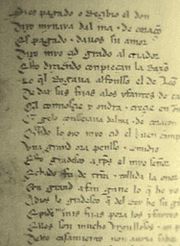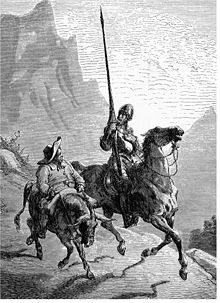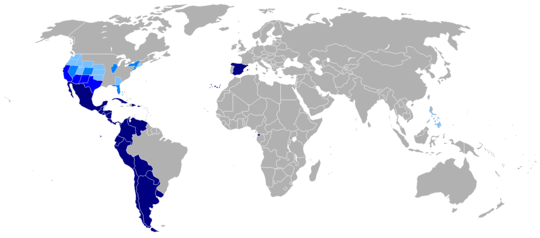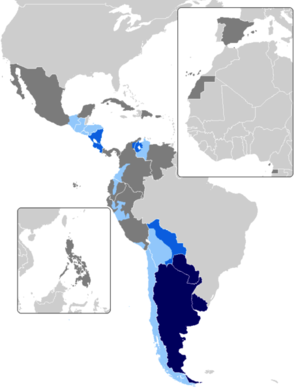
Spanish language
Background Information
SOS Children, an education charity, organised this selection. Do you want to know about sponsoring? See www.sponsorachild.org.uk
| Spanish, Castilian | |
|---|---|
| Español, Castellano | |
| Pronunciation | /espaˈɲol/, /kasteˈʎano/ - /kasteˈʝano/ |
| Region | Spanish speaking countries: and a significant number of the populations of and the |
| Native speakers | First languagea: 322– c. 400 million Totala: 400–500 million aAll numbers are approximate. (date missing) |
| Language family |
Indo-European
|
| Writing system | Latin ( Spanish variant) |
| Official status | |
| Official language in | 21 countries |
| Regulated by | [[Association of Spanish Language Academies|Asociación de Academias de la Lengua Española]] ( Real Academia Española and 21 other national Spanish language academies) |
| Language codes | |
| ISO 639-1 | es |
| ISO 639-2 | spa |
| ISO 639-3 | spa |
Spanish (español) or Castilian (castellano) is an Indo-European, Romance language that originated in northern Spain, and gradually spread in the Kingdom of Castile and evolved into the principal language of government and trade. It was taken to Africa, the Americas, and Asia Pacific with the expansion of the Spanish Empire between the fifteenth and nineteenth centuries.
Today, between 322 and 400 million people speak Spanish as a native language, making it the world's second most-spoken language by native speakers (after Mandarin Chinese).
Hispanosphere
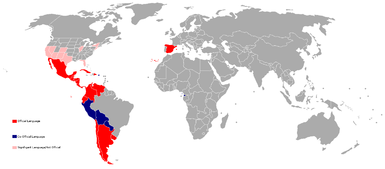 |
||||
|
Spanish identified as the sole Official language
Spanish identified as a Co-Official language
|
||||
| The Countries of the Hispanic-influenced World | ||||
It is estimated that the combined total of native and non-native Spanish speakers is approximately 500 million, likely making it the third most spoken language by total number of speakers (after English and Chinese).
Today, Spanish is an official language of Spain, most Latin American countries, and Equatorial Guinea; 21 nations speak it as their primary language. Spanish also is one of six official languages of the United Nations. Mexico has the world's largest Spanish-speaking population, and Spanish is the second most-widely spoken language in the United States and the most popular studied foreign language in U.S. schools and universities. Global internet usage statistics for 2007 show Spanish as the third most commonly used language on the Internet, after English and Chinese.
Naming and origin
Spaniards tend to call this language español (Spanish) when contrasting it with languages of other states, such as French and English, but call it castellano (Castilian), that is, the language of the Castile region, when contrasting it with other languages spoken in Spain such as Galician, Basque, and Catalan. This reasoning also holds true for the language's preferred name in some Hispanic American countries. In this manner, the Spanish Constitution of 1978 uses the term castellano to define the official language of the whole Spanish State, as opposed to las demás lenguas españolas (lit. the other Spanish languages). Article III reads as follows:
| “ | El castellano es la lengua española oficial del Estado. (…) Las demás lenguas españolas serán también oficiales en las respectivas Comunidades Autónomas… Castilian is the official Spanish language of the State. (…) The other Spanish languages shall also be official in their respective Autonomous Communities… |
” |
The name castellano is, however, widely used for the language as a whole in Latin America. Some Spanish speakers consider castellano a generic term with no political or ideological links, much as "Spanish" is in English. Often Latin Americans use it to differentiate their own variety of Spanish as opposed to the variety of Spanish spoken in Spain, or variety of Spanish which is considered as standard in the region.
Spanish is closely related to the other West Iberian Romance languages: Asturian (asturianu), Galician (galego), Ladino (dzhudezmo/spanyol/kasteyano), and Portuguese (português). Catalan, an East Iberian language which exhibits many Gallo-Romance traits, is more similar to the neighbouring Occitan language (occitan) than to Spanish, or indeed than Spanish and Portuguese are to each other.
Spanish and Portuguese share similar grammars and vocabulary as well as a common history of Arabic influence while a great part of the peninsula was under Islamic rule (both languages expanded over Islamic territories). Their lexical similarity has been estimated as 89%. See Differences between Spanish and Portuguese for further information.
Ladino
Ladino, which is essentially medieval Spanish and closer to modern Spanish than any other language, is spoken by many descendants of the Sephardi Jews who were expelled from Spain in the 15th century. Ladino speakers are currently almost exclusively Sephardi Jews, with family roots in Turkey, Greece or the Balkans: current speakers mostly live in Israel and Turkey, with a few pockets in Latin America. It lacks the Native American vocabulary which was influential during the Spanish colonial period, and it retains many archaic features which have since been lost in standard Spanish. It contains, however, other vocabulary which is not found in standard Castilian, including vocabulary from Hebrew, some French, Greek and Turkish, and other languages spoken where the Sephardim settled.
Ladino is in serious danger of extinction because many native speakers today are elderly as well as elderly olim (immigrants to Israel) who have not transmitted the language to their children or grandchildren. However, it is experiencing a minor revival among Sephardi communities, especially in music. In the case of the Latin American communities, the danger of extinction is also due to the risk of assimilation by modern Castilian.
A related dialect is Haketia, the Judaeo-Spanish of northern Morocco. This too tended to assimilate with modern Spanish, during the Spanish occupation of the region.
Vocabulary comparison
Spanish and Italian share a very similar phonological system. At present, the lexical similarity with Italian is estimated at 82%. As a result, Spanish and Italian are mutually intelligible to various degrees. The lexical similarity with Portuguese is greater, 89%, but the vagaries of Portuguese pronunciation make it less easily understood by Hispanophones than Italian. Mutual intelligibility between Spanish and French or Romanian is even lower (lexical similarity being respectively 75% and 71%): comprehension of Spanish by French speakers who have not studied the language is as low as an estimated 45% - the same as of English. The common features of the writing systems of the Romance languages allow for a greater amount of interlingual reading comprehension than oral communication would.
| Latin | Spanish | Galician | Portuguese | Catalan | Italian | French | Romanian | English |
|---|---|---|---|---|---|---|---|---|
| nos | nosotros | nós/nosoutros | nós¹ | nosaltres | noi² | nous³ | noi | we |
| fratrem germānum (acc.) (lit. "true brother", i.e. not a cousin) | hermano | irmán | irmão | germà | fratello | frère | frate | brother |
| dies Martis ( Classical) tertia feria |
martes | martes | terça-feira | dimarts | martedì | mardi | marți | Tuesday |
| cantiō (nem, acc.), canticum | canción | canción | canção | cançó | canzone | chanson | cântec | song |
| magis or plus | más (archaically also plus) |
máis | mais (archaically also chus) |
més (archaically also pus) |
più | plus | mai | more |
| manum sinistram (acc.) | mano izquierda also (mano siniestra) |
man esquerda | mão esquerda (archaically also sẽestra) |
mà esquerra | mano sinistra | main gauche | mâna stângă | left hand |
| nihil or nullam rem natam (acc.) (lit. "no thing born") |
nada | nada/ren | nada (archaically also rem) |
res | niente/nulla | rien/nul | nimic | nothing |
1. also nós outros in early modern Portuguese (e.g. The Lusiads)
2. noi altri in Southern Italian dialects and languages
3. Alternatively nous autres
History
Spanish evolved from Vulgar Latin, with minor influences from Arabic during the Andalusian period and from Basque and Celtiberian, and some Germanic languages via the Visigoths. Spanish developed along the remote cross road strips among the Alava, Cantabria, Burgos, Soria and La Rioja provinces of Northern Spain, as a strongly innovative and differing variant from its nearest cousin, Leonese speech, with a higher degree of Basque influence in these regions (see Iberian Romance languages). Typical features of Spanish diachronical phonology include lenition (Latin vita, Spanish vida), palatalization (Latin annum, Spanish año, and Latin anellum, Spanish anillo) and diphthongation ( stem-changing) of short e and o from Vulgar Latin (Latin terra, Spanish tierra; Latin novus, Spanish nuevo). Similar phenomena can be found in other Romance languages as well.
During the Reconquista, this northern dialect from Cantabria was carried south, and remains a minority language in the northern coastal Morocco.
The first Latin-to-Spanish grammar (Gramática de la Lengua Castellana) was written in Salamanca, Spain, in 1492, by Elio Antonio de Nebrija. When it was presented to Isabel de Castilla, she asked, "What do I want a work like this for, if I already know the language?", to which he replied, "Your highness, the language is the instrument of the Empire."
From the 16th century onwards, the language was taken to the Americas and the Spanish East Indies via Spanish colonization, and in that epoch, Spanish became the principal language of politics and Art in most of Europe; French replaced it in the 18th century.
In the 20th century, Spanish was introduced to Equatorial Guinea and the Western Sahara, the United States, such as in Spanish Harlem, in New York City, that had not been part of the Spanish Empire. For details on borrowed words and other external influences upon Spanish, see Influences on the Spanish language.
Characterization
A defining characteristic of Spanish was the diphthongization of the Latin short vowels e and o into ie and ue, respectively, when they were stressed. Similar sound changes are found in other Romance languages, but in Spanish they were significant. Some examples:
- Lat. petra > Sp. piedra, It. pietra, Fr. pierre, Rom. piatrǎ, Port./Gal. pedra "stone".
- Lat. moritur > Sp. muere, It. muore, Fr. meurt / muert, Rom. moare, Port./Gal. morre "die".
Peculiar to early Spanish (as in the Gascon dialect of Occitan, and possibly due to a Basque substratum) was the mutation of Latin initial f- into h- whenever it was followed by a vowel that did not diphthongate. Compare for instance:
- Lat. filium > It. figlio, Port. filho, Gal. fillo, Fr. fils, Occitan filh (but Gascon hilh) Sp. hijo (but Ladino fijo);
- Lat. fabulari > Lad. favlar, Port./Gal. falar, Sp. hablar;
- but Lat. focum > It. fuoco, Port./Gal. fogo, Sp./Lad. fuego.
Some consonant clusters of Latin also produced characteristically different results in these languages, for example:
- Lat. clamare, acc. flammam, plenum > Lad. lyamar, flama, pleno; Sp. llamar, llama, lleno. However, in Spanish there are also the forms clamar, flama, pleno; Port. chamar, chama, cheio; Gal. chamar, chama, cheo.
- Lat. acc. octo, noctem, multum > Lad. ocho, noche, muncho; Sp. ocho, noche, mucho; Port. oito, noite, muito; Gal. oito, noite, moito.
Geographic distribution
| Spanish language |
|---|
|
The main characters of Don Quixote,
a master work in Spanish literature. |
| Overview |
|
| Grammar |
|
Spanish is one of the official languages of the European Union, the Organization of American States, the Organization of Ibero-American States, the United Nations, and the Union of South American Nations.
Europe
Spanish is an official language of Spain, the country for which it is named and from which it originated. It is also spoken in Gibraltar, though English is the official language. Likewise, it is spoken in Andorra though Catalan is the official language. It is also spoken by small communities in other European countries, such as the United Kingdom, France, and Germany. Spanish is an official language of the European Union. In Switzerland, Spanish is the mother tongue of 1.7% of the population, representing the first minority after the 4 official languages of the country.
The Americas
Latin America
Most Spanish speakers are in Latin America; of most countries with the most Spanish speakers, only Spain is outside of the Americas. Mexico has most of the world's native speakers. Nationally, Spanish is the official language of Argentina, Bolivia (co-official Quechua and Aymara), Chile, Colombia, Costa Rica, Cuba, Dominican Republic, Ecuador, El Salvador, Guatemala, Honduras, Mexico , Nicaragua, Panama, Paraguay (co-official Guaraní), Peru (co-official Quechua and, in some regions, Aymara), Uruguay, and Venezuela. Spanish is also the official language (co-official with English) in the U.S. commonwealth of Puerto Rico.
Spanish has no official recognition in the former British colony of Belize; however, per the 2000 census, it is spoken by 43% of the population. Mainly, it is spoken by Hispanic descendants who remained in the region since the 17th century; however, English is the official language.
Spain colonized Trinidad and Tobago first in 1498, leaving the Carib people the Spanish language. Also the Cocoa Panyols, laborers from Venezuela, took their culture and language with them; they are accredited with the music of " Parang" (" Parranda") on the island. Because of Trinidad's location on the South American coast, the country is much influenced by its Spanish-speaking neighbors. A recent census shows that more than 1,500 inhabitants speak Spanish. In 2004, the government launched the Spanish as a First Foreign Language (SAFFL) initiative in March 2005. Government regulations require Spanish to be taught, beginning in primary school, while thirty percent of public employees are to be linguistically competent within five years. The government also announced that Spanish will be the country's second official language by 2020, beside English.
Spanish is important in Brazil because of its proximity to and increased trade with its Spanish-speaking neighbors; for example, as a member of the Mercosur trading bloc. In 2005, the National Congress of Brazil approved a bill, signed into law by the President, making Spanish available as a foreign language in secondary schools. In many border towns and villages (especially on the Uruguayan-Brazilian border), a mixed language known as Portuñol is spoken.
United States
In the 2006 census, 44.3 million people of the U.S. population were Hispanic or Latino by origin; 34 million people, 12.2 percent, of the population older than 5 years speak Spanish at home.Spanish has a long history in the United States (many south-western states were part of Mexico and Spain), and it recently has been revitalized by much immigration from Latin America. Spanish is the most widely taught foreign language in the country. Although the United States has no formally designated "official languages," Spanish is formally recognized at the state level beside English; in the U.S. state of New Mexico, 30 per cent of the population speak it. It also has strong influence in metropolitan areas such as Los Angeles, Miami and New York City. Spanish is the dominant spoken language in Puerto Rico, a U.S. territory. In total, the U.S. has the world's fifth-largest Spanish-speaking population.
Asia
Spanish was an official language of the Philippines but was never spoken by a majority of the population. Movements for most of the masses to learn the language were started but were stopped by the friars. Its importance fell in the first half of the 20th century following the U.S. occupation and administration of the islands. The introduction of the English language in the Philippine government system put an end to the use of Spanish as the official language. The language lost its official status in 1973 during the Ferdinand Marcos administration.
Spanish is spoken mainly by small communities of Filipino-born Spaniards, Latin Americans, and Filipino mestizos (mixed race), descendants of the early colonial Spanish settlers. Throughout the 20th century, the Spanish language has declined in importance compared to English and Tagalog. According to the 1990 Philippine census, there were 2,658 native speakers of Spanish. No figures were provided during the 1995 and 2000 censuses; however, figures for 2000 did specify there were over 600,000 native speakers of Chavacano, a Spanish based creole language spoken in Cavite and Zamboanga. Some other sources put the number of Spanish speakers in the Philippines around two to three million; however, these sources are disputed. In Tagalog, there are 4,000 Spanish adopted words and around 6,000 Spanish adopted words in Visayan and other Philippine languages as well. Today Spanish is offered as a foreign language in Philippines schools and universities.
Africa
In Africa, Spanish is official in the UN-recognised but Moroccan-occupied Western Sahara (co-official Arabic) and Equatorial Guinea (co-official French and Portuguese). Today, nearly 200,000 refugee Sahrawis are able to read and write in Spanish, and several thousands have received university education in foreign countries as part of aid packages (mainly Cuba and Spain). In Equatorial Guinea, Spanish is the predominant language when counting native and non-native speakers (around 500,000 people), while Fang is the most spoken language by a number of native speakers. It is also spoken in the Spanish cities in continental North Africa ( Ceuta and Melilla) and in the autonomous community of Canary Islands (143,000 and 1,995,833 people, respectively). Within Northern Morocco, a former Franco-Spanish protectorate that is also geographically close to Spain, approximately 20,000 people speak Spanish. It is spoken by some communities of Angola, because of the Cuban influence from the Cold War, and in Nigeria by the descendants of Afro-Cuban ex-slaves. In Côte d'Ivoire and Senegal, Spanish can be learned as a second foreign language in the public education system. In 2008, Cervantes Institutes centers will be opened in Lagos and Johannesburg, the first one in the Sub-Saharan Africa
Oceania
Among the countries and territories in Oceania, Spanish is also spoken in Easter Island, a territorial possession of Chile. According to the 2001 census, there are approximately 95,000 speakers of Spanish in Australia, 44,000 of which live in Greater Sydney, where the older Mexican, Colombian, and Spanish populations and newer Argentine, Salvadoran and Uruguyan communities live.
The island nations of Guam, Palau, Northern Marianas, Marshall Islands and Federated States of Micronesia all once had Spanish speakers, since Marianas and Caroline Islands were Spanish colonial possessions until late 19th century (see Spanish-American War), but Spanish has since been forgotten. It now only exists as an influence on the local native languages and also spoken by Hispanic American resident populations.
Dialectal variation
There are important variations among the regions of Spain and throughout Spanish-speaking America. In countries in Hispanophone America, it is preferable to use the word castellano to distinguish their version of the language from that of Spain, thus asserting their autonomy and national identity. In Spain the Castilian dialect's pronunciation is commonly regarded as the national standard, although a use of slightly different pronouns called [[Loísmo|laísmo]] of this dialect is deprecated. More accurately, for nearly everyone in Spain, "standard Spanish" means "pronouncing everything exactly as it is written," an ideal which does not correspond to any real dialect, though the northern dialects are the closest to it. In practice, the standard way of speaking Spanish in the media is "written Spanish" for formal speech, "Madrid dialect" (one of the transitional variants between Castilian and Andalusian) for informal speech.
Voseo
Spanish has three second-person singular pronouns: tú, usted, and in some parts of Latin America, vos (the use of this pronoun and/or its verb forms is called voseo). In those regions where it is used, generally speaking, tú and vos are informal and used with friends; in other countries, vos is considered an archaic form. Usted is universally regarded as the formal address (derived from vuestra merced, "your grace"), and is used as a mark of respect, as when addressing one's elders or strangers.
Vos is used extensively as the primary spoken form of the second-person singular pronoun, although with wide differences in social consideration, in many countries of Latin America, including Argentina, Chile, Costa Rica, the central mountain region of Ecuador, the State of Chiapas in Mexico, El Salvador, Guatemala, Honduras, Nicaragua, Paraguay, Uruguay, the Paisa region and Caleños of Colombia and the States of Zulia and Trujillo in Venezuela. There are some differences in the verbal endings for vos in each country. In Argentina, Uruguay, and increasingly in Paraguay and some Central American countries, it is also the standard form used in the media, but the media in other countries with voseo generally continue to use usted or tú except in advertisements, for instance. Vos may also be used regionally in other countries. Depending on country or region, usage may be considered standard or (by better educated speakers) to be unrefined. Interpersonal situations in which the use of vos is acceptable may also differ considerably between regions.
Writing system
Spanish is written using the Latin alphabet, with the addition of the character ñ (eñe, representing the phoneme /ɲ/, a letter distinct from n, although typographically composed of an n with a tilde) and the digraphs ch (che, representing the phoneme /tʃ/) and ll (elle, representing the phoneme /ʎ/). However, the digraph rr (erre fuerte, "strong r", erre doble, "double r", or simply erre), which also represents a distinct phoneme /r/, is not similarly regarded as a single letter. Since 1994, the digraphs ch and ll are to be treated as letter pairs for collation purposes, though they remain a part of the alphabet. Words with ch are now alphabetically sorted between those with ce and ci, instead of following cz as they used to, and similarly for ll.
Thus, the Spanish alphabet has the following 29 letters:
- a, b, c, ch, d, e, f, g, h, i, j, k, l, ll, m, n, ñ, o, p, q, r, s, t, u, v, w, x, y, z.
With the exclusion of a very small number of regional terms such as México (see Toponymy of Mexico), pronunciation can be entirely determined from spelling. A typical Spanish word is stressed on the syllable before the last if it ends with a vowel (not including y) or with a vowel followed by n or s; it is stressed on the last syllable otherwise. Exceptions to this rule are indicated by placing an acute accent on the stressed vowel.
The acute accent is used, in addition, to distinguish between certain homophones, especially when one of them is a stressed word and the other one is a clitic: compare el ("the", masculine singular definite article) with él ("he" or "it"), or te ("you", object pronoun), de (preposition "of" or "from"), and se (reflexive pronoun) with té ("tea"), dé ("give") and sé ("I know", or imperative "be").
The interrogative pronouns (qué, cuál, dónde, quién, etc.) also receive accents in direct or indirect questions, and some demonstratives (ése, éste, aquél, etc.) can be accented when used as pronouns. The conjunction o ("or") is written with an accent between numerals so as not to be confused with a zero: e.g., 10 ó 20 should be read as diez o veinte rather than diez mil veinte ("10,020"). Accent marks are frequently omitted in capital letters (a widespread practice in the early days of computers where only lowercase vowels were available with accents), although the RAE advises against this.
When u is written between g and a front vowel (e or i), if it should be pronounced, it is written with a diaeresis (ü) to indicate that it is not silent as it normally would be (e.g., cigüeña, "stork", is pronounced /θiˈɣweɲa/; if it were written cigueña, it would be pronounced /θiˈɣeɲa/.
Interrogative and exclamatory clauses are introduced with inverted question ( ¿ ) and exclamation ( ¡ ) marks.
Sounds
The phonemic inventory listed in the following table includes phonemes that are preserved only in some dialects, other dialects having merged them (such as yeísmo); these are marked with an asterisk (*). Sounds in parentheses are allophones.
| Bilabial | Labio- dental |
Dental | Alveolar | Palatal | Velar | |
|---|---|---|---|---|---|---|
| Nasal | m | n | ɲ | |||
| Stop | p b | t d | tʃ (ɟʝ) | k g | ||
| Fricative | f (v) | *θ (ð) | s (z) | ʝ | x | |
| Approximant | (β̞) | (ð̞) | (ɣ˕) | |||
| Trill | r | |||||
| Tap | ɾ | |||||
| Lateral | l | *ʎ | ||||
By the 16th century, the consonant system of Spanish underwent the following important changes that differentiated it from neighboring Romance languages such as Portuguese and Catalan:
- Initial /f/, when it had evolved into a vacillating /h/, was lost in most words (although this etymological h- is preserved in spelling and in some Andalusian dialects is still aspirated).
- The bilabial approximant /β̞/ (which was written u or v) merged with the bilabial oclusive /b/ (written b). There is no difference between the pronunciation of orthographic b and v in contemporary Spanish, excepting emphatic pronunciations that cannot be considered standard or natural.
- The voiced alveolar fricative /z/ which existed as a separate phoneme in medieval Spanish merged with its voiceless counterpart /s/. The phoneme which resulted from this merger is currently spelled s.
- The voiced postalveolar fricative /ʒ/ merged with its voiceless counterpart /ʃ/, which evolved into the modern velar sound /x/ by the 17th century, now written with j, or g before e, i. Nevertheless, in most parts of Argentina and in Uruguay, y and ll have both evolved to /ʒ/ or /ʃ/.
- The voiced alveolar affricate /dz/ merged with its voiceless counterpart /ts/, which then developed into the interdental /θ/, now written z, or c before e, i. But in Andalusia, the Canary Islands and the Americas this sound merged with /s/ as well. See Ceceo, for further information.
The consonant system of Medieval Spanish has been better preserved in Ladino and in Portuguese, neither of which underwent these shifts.
Lexical stress
Spanish is a syllable-timed language, so each syllable has the same duration regardless of stress. Stress most often occurs on any of the last three syllables of a word, with some rare exceptions at the fourth last. The tendencies of stress assignment are as follows:
- In words ending in vowels and /s/, stress most often falls on the penultimate syllable.
- In words ending in all other consonants, the stress more often falls on the ultimate syllable.
- Preantepenultimate stress occurs rarely and only in words like guardándoselos ('saving them for him/her') where a clitic follows certain verbal forms.
In addition to the many exceptions to these tendencies, there are numerous minimal pairs which contrast solely on stress. For example, sabana, with penultimate stress, means 'savannah' while sábana, with antepenultimate stress, means 'sheet'; límite ('boundary'), limite ('[that] he/she limits') and limité ('I limited') also contrast solely on stress.
Phonological stress may be marked orthographically with an acute accent (ácido, distinción, etc). This is done according to the mandatory stress rules of Spanish orthography which are similar to the tendencies above (differing with words like distinción) and are defined so as to unequivocally indicate where the stress lies in a given written word. An acute accent may also be used to differentiate homophones (such as té for 'tea' and te
An amusing example of the significance of intonation in Spanish is the phrase ¿Cómo "cómo como"? ¡Como como como! ("What do you mean / 'how / do I eat'? / I eat / the way / I eat!").
Grammar
Spanish is a relatively inflected language, with a two- gender system and about fifty conjugated forms per verb, but limited inflection of nouns, adjectives, and determiners. (For a detailed overview of verbs, see Spanish verbs and Spanish irregular verbs.)
It is right-branching, uses prepositions, and usually, though not always, places adjectives after nouns. Its syntax is generally Subject Verb Object, though variations are common. It is a pro-drop language (allows the deletion of pronouns when pragmatically unnecessary) and verb-framed.

